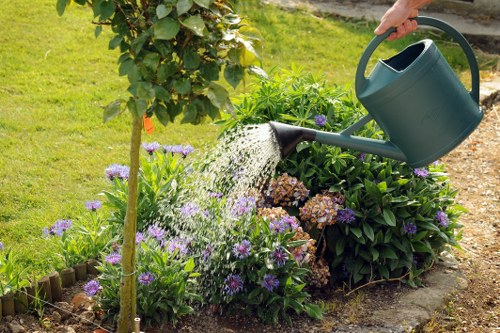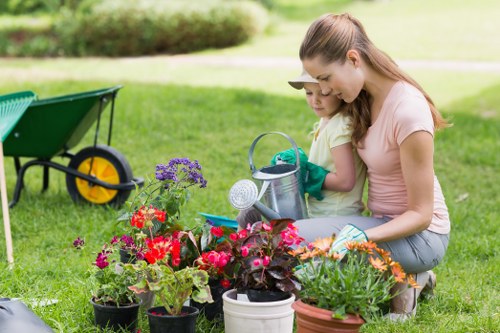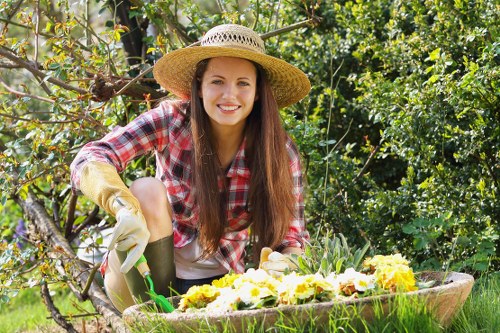Gardener Plumstead: Your Ultimate Guide to Thriving Gardens

Welcome to Gardener Plumstead, where we transform ordinary spaces into vibrant, flourishing gardens. Whether you're a seasoned green thumb or just starting your gardening journey, Plumstead offers a wealth of opportunities to cultivate beauty and serenity right in your backyard.
Plumstead, located in the heart of southeast London, is renowned for its community spirit and love for greenery. With the right knowledge and tools, anyone can create a stunning garden that not only enhances their home but also contributes to the local ecosystem.
In this comprehensive guide, we'll explore everything you need to know about gardening in Plumstead, from selecting the right plants to maintaining a healthy garden year-round.

Choosing the Right Plants for Plumstead
One of the first steps in creating a beautiful garden is selecting plants that thrive in Plumstead's climate and soil conditions. Understanding your local environment will help ensure your plants flourish.
Plumstead experiences a temperate maritime climate, which means mild winters and warm summers. This climate is ideal for a wide variety of plants, including perennials, shrubs, and even some trees.
When choosing plants, consider factors such as sunlight exposure, soil type, and water availability. Native plants are often the best choice as they are well-adapted to local conditions and require less maintenance.

Soil Preparation and Maintenance
Healthy soil is the foundation of a thriving garden. Before planting, it's essential to test your soil to determine its pH level and nutrient content. This information will guide you in amending the soil to create optimal growing conditions.
Adding organic matter, such as compost or well-rotted manure, can improve soil structure, enhance fertility, and promote beneficial microbial activity. Regularly aerating the soil and mulching around plants also helps retain moisture and suppress weeds.
Maintaining soil health involves routine practices like crop rotation, cover cropping, and avoiding the overuse of chemical fertilizers and pesticides. By nurturing your soil, you'll ensure your plants have the best possible environment to grow.

Garden Design and Layout
Designing your garden layout is a creative and rewarding process. Start by assessing the available space and determining the primary purpose of your garden, whether it's for relaxation, growing vegetables, or attracting pollinators.
Consider incorporating elements such as pathways, seating areas, and water features to enhance the functionality and aesthetics of your garden. Layering plants of different heights and textures can add depth and interest to the space.
Using sustainable design principles, like incorporating native plants and efficient irrigation systems, can make your garden more eco-friendly and easier to maintain. A well-thought-out design will not only look beautiful but also support the health and diversity of your garden ecosystem.

Seasonal Gardening Tips
Gardening is a year-round activity, and each season offers unique opportunities and challenges. Adapting your gardening practices to the changing seasons can help your garden thrive throughout the year.
Spring
Spring is the perfect time to prepare your garden for the growing season. Start by clearing any debris from winter and preparing the soil. Planting early bloomers and establishing new perennials can set the stage for a vibrant garden.
Summer
During summer, focus on watering, weeding, and protecting your plants from excessive heat. Regular maintenance and monitoring can help prevent pests and diseases from taking hold.
Autumn
Autumn is ideal for planting bulbs and preparing your garden for winter. It's also a great time to harvest late-season vegetables and add mulch to protect plant roots from the cold.
Winter
In winter, concentrate on planning for the next growing season. Pruning and protecting sensitive plants can ensure they remain healthy and ready to flourish when spring arrives.
Local Resources and Communities
Plumstead boasts a vibrant community of gardening enthusiasts and several local resources to support your gardening endeavors.
- Plumstead Community Garden: A shared space where residents can grow their own plants and exchange gardening tips.
- Local Nurseries: Offering a wide selection of plants suited to Plumstead's climate, as well as expert advice.
- Gardening Workshops: Regular workshops and classes are available to help you improve your gardening skills.
- Online Forums: Connect with fellow gardeners in Plumstead through online platforms to share experiences and ask questions.
Engaging with local resources and communities can provide invaluable support and inspiration, making your gardening journey in Plumstead more enjoyable and successful.
10-15 Nearby Areas to Plumstead
Plumstead is surrounded by several charming neighborhoods, each offering unique features and opportunities for gardeners. Here are some of the closest areas to consider:
- Woolwich: Just north of Plumstead, Woolwich offers expansive parks and community gardens perfect for gardening enthusiasts.
- Greenhithe: Located to the southeast, Greenhithe is known for its beautiful riverside gardens and green spaces.
- Eltham: West of Plumstead, Eltham boasts historic gardens and a variety of plant species suitable for different garden styles.
- Kidbrooke: Close by, Kidbrooke has modern gardening facilities and events that cater to all skill levels.
- Northfleet: Northeast of Plumstead, Northfleet is home to several community-led gardening projects and workshops.
- Lewisham: Situated to the northwest, Lewisham features extensive botanical gardens and green initiatives.
- North Greenwich: East of Plumstead, North Greenwich offers unique urban gardening opportunities and rooftop gardens.
- Blackheath: Southwest, Blackheath provides serene garden spaces and a variety of plant nurseries.
- Ashford: South of Plumstead, Ashford is known for its family-friendly gardens and local horticultural societies.
- Charlton: Adjacent to Plumstead, Charlton has a blend of traditional and contemporary gardens, perfect for inspiration.
- Greenwich A bit further west, Greenwich offers world-renowned gardens and extensive horticultural resources.
- Deptford: North-east, Deptford features community gardens and urban farming initiatives.
- Banstead: While further out, Banstead is worth mentioning for its large private gardens and green estates.
- Kidbrooke Village: Close to Plumstead, this area combines modern living with green spaces ideal for gardening enthusiasts.
- Liberty Park: Just north, Liberty Park is a hub for local gardening events and plant exchanges.
Each of these areas offers unique gardening opportunities and communities, providing ample support and inspiration for gardeners in Plumstead.
Essential Gardening Tools and Equipment
Having the right tools can make gardening tasks easier and more enjoyable. Here are some essential tools every gardener in Plumstead should consider:
- Hand Trowel: Perfect for digging small holes, planting seeds, and transferring plants.
- Pruning Shears: Essential for trimming and shaping plants, ensuring they grow healthy and strong.
- Garden Fork: Useful for turning soil, removing weeds, and aerating garden beds.
- Watering Can or Hose: Necessary for providing consistent moisture to your plants, especially during dry spells.
- Gardening Gloves: Protect your hands from thorns, dirt, and potential injuries while working in the garden.
- Wheelbarrow: Helps in transporting soil, compost, plants, and other materials around your garden.
- Rake: Great for leveling soil, removing debris, and spreading mulch evenly.
- Hoe: Ideal for weeding and cultivating the soil to prevent weed growth.
Investing in quality gardening tools can significantly enhance your gardening experience, making tasks more efficient and enjoyable.
Attracting Wildlife to Your Garden
A thriving garden not only looks beautiful but also supports local wildlife. Attracting birds, bees, butterflies, and other creatures can create a lively and balanced ecosystem.
Plant Selection
Choose a variety of plants that provide nectar, pollen, and seeds to attract different types of wildlife. Flowers like lavender, sunflowers, and marigolds are excellent for attracting pollinators.
Habitat Features
Include features such as birdhouses, bee hotels, and butterfly feeders to create habitats for your garden visitors. Providing water sources, like birdbaths or small ponds, can also encourage wildlife to visit.
Sustainable Practices
Avoid using pesticides and herbicides, as these can harm beneficial insects and animals. Instead, opt for natural pest control methods and encourage predators like ladybugs and praying mantises to keep pest populations in check.
By creating a wildlife-friendly garden, you contribute to the local biodiversity and enjoy the beauty of nature up close.
Common Gardening Challenges in Plumstead
Every garden faces its own set of challenges. Understanding and addressing these issues can help ensure your Plumstead garden remains healthy and vibrant.
Pests and Diseases
Pests like aphids, slugs, and caterpillars can damage your plants. Identifying and managing these pests early is crucial. Use natural remedies and encourage beneficial insects to keep pest populations under control.
Soil Compaction
Compacted soil can restrict root growth and reduce water infiltration. Regularly aerate your soil and add organic matter to improve its structure and drainage.
Watering Issues
Overwatering or underwatering can stress plants and make them more susceptible to disease. Establish a consistent watering schedule and use mulch to retain soil moisture.
Weed Control
Weeds compete with your plants for nutrients and water. Regular weeding and the use of mulch can help minimize weed growth and maintain a tidy garden.
Climate Variability
Unexpected weather changes, such as frost or heatwaves, can impact your garden. Protect sensitive plants with frost covers and provide shade or additional water during heatwaves.
Sustainable Gardening Practices
Adopting sustainable gardening practices can benefit both your garden and the environment. Here are some tips to make your Plumstead garden more eco-friendly:
- Composting: Recycle kitchen scraps and garden waste to create nutrient-rich compost for your plants.
- Rainwater Harvesting: Collect rainwater to use for watering your garden, reducing your reliance on tap water.
- Native Plants: Use native species that are well-adapted to local conditions and require less maintenance.
- Organic Fertilizers: Opt for natural fertilizers to enhance soil fertility without harming beneficial organisms.
- Integrated Pest Management: Combine biological, cultural, and mechanical methods to manage pests sustainably.
By incorporating these practices, you contribute to a healthier environment and create a resilient garden that can withstand various challenges.
Benefits of Gardening in Plumstead
Gardening offers numerous benefits, both physical and mental. Here are some of the advantages of maintaining a garden in Plumstead:
Physical Health
Gardening involves various physical activities like digging, planting, and pruning, which can improve strength, flexibility, and overall fitness.
Mental Well-being
Spending time in the garden reduces stress, enhances mood, and promotes relaxation. The act of nurturing plants can also increase feelings of accomplishment and purpose.
Environmental Impact
A well-maintained garden supports local biodiversity, improves air quality, and reduces the urban heat island effect by providing green cover.
Economic Savings
Growing your own vegetables and herbs can save money on groceries, while a beautiful garden can increase your home's property value.
Community Engagement
Gardening can foster a sense of community as you connect with neighbors, participate in local gardening events, and contribute to shared green spaces.
Maintaining Your Plumstead Garden Year-Round
Keeping your garden in top shape requires consistent effort and attention throughout the year. Here are some maintenance tips to ensure your Plumstead garden remains healthy and beautiful:
Regular Pruning
Prune plants and trees to remove dead or diseased branches, improve airflow, and shape plants for better growth.
Weeding
Keep weeds under control by regularly removing them and using mulch to prevent new growth.
Fertilizing
Feed your plants with appropriate fertilizers to provide essential nutrients and promote vigorous growth.
Pest Monitoring
Regularly inspect your plants for signs of pests and diseases, and take prompt action to address any issues.
Water Management
Ensure your garden receives adequate water, adjusting your watering schedule based on seasonal needs and weather conditions.
By staying on top of these maintenance tasks, your garden will thrive and continue to be a source of joy and beauty.
Innovative Gardening Techniques
Embracing innovative gardening techniques can enhance your gardening experience and improve your garden's productivity. Here are some modern approaches to consider:
Vertical Gardening
Maximize space by growing plants vertically using trellises, wall-mounted planters, or stacked containers. This technique is especially useful for small gardens and urban settings.
Hydroponics
Grow plants without soil by using nutrient-rich water solutions. Hydroponics can accelerate plant growth and reduce water usage.
Companion Planting
Plant compatible species together to enhance growth, deter pests, and improve soil health. For example, planting basil alongside tomatoes can enhance flavor and repel insects.
Permaculture
Create a self-sustaining garden ecosystem by integrating plants, animals, and natural resources in a harmonious way. Permaculture focuses on sustainability and resilience.
Smart Irrigation Systems
Use technology to optimize watering schedules and conserve water. Smart irrigation systems can adjust based on weather conditions and soil moisture levels.
Incorporating these techniques can make your garden more efficient, productive, and environmentally friendly.
Gardening for Different Spaces
No matter the size or type of your outdoor space, there's a way to incorporate gardening into your lifestyle. Here are some ideas for different spaces:
Backyard Gardens
Backyards offer ample space for a variety of plants, including vegetables, flowers, and fruit trees. Design your backyard garden with designated areas for different plant types and consider adding features like patios or pergolas for outdoor living.
Balconies and Terraces
Transform small balconies or terraces into green oases with container gardening. Use hanging planters, vertical gardens, and compact plant varieties to make the most of limited space.
Rooftop Gardens
If you have access to a rooftop, create a unique garden with raised beds, lightweight plants, and wind-resistant species. Rooftop gardens can provide stunning views and additional green space in urban areas.
Urban Gardens
Urban gardens can thrive in community plots, vertical structures, or even window boxes. Focus on plants that require minimal space and maintenance to ensure success in a bustling city environment.
Indoor Gardens
Bring the beauty of gardening indoors with houseplants, herbs, and small-scale hydroponic systems. Indoor gardens can improve air quality and add a touch of nature to your living spaces.
Regardless of your space, thoughtful planning and the right plant choices can help you create a beautiful and functional garden.
Gardener Plumstead: A Community Effort
Gardening in Plumstead is more than just a hobby; it's a community effort that brings people together. By collaborating with your neighbors and participating in local gardening initiatives, you can enhance your gardening experience and contribute to the neighborhood's green spaces.
Community Projects
Join or initiate community gardening projects, such as park clean-ups, shared garden spaces, or tree-planting events. These projects foster a sense of ownership and pride in your local environment.
Workshops and Events
Attend local workshops and gardening events to learn new skills, discover innovative techniques, and connect with fellow gardeners. These gatherings are great opportunities for knowledge sharing and inspiration.
Volunteer Opportunities
Volunteer your time and expertise to support community gardens and green initiatives. Giving back to your community can strengthen social bonds and promote a greener, healthier Plumstead.
By embracing the community aspect of gardening, you not only improve your own garden but also help create a more vibrant and sustainable neighborhood.
Conclusion
Gardener Plumstead offers a wealth of opportunities for anyone passionate about creating and maintaining beautiful gardens. By understanding the local climate, selecting the right plants, and engaging with the community, you can cultivate a thriving garden that enhances both your home and the environment.
Remember, gardening is a journey that requires patience, dedication, and a love for nature. With the tips and insights provided in this guide, you're well on your way to becoming a successful gardener in Plumstead.
Frequently Asked Questions
1. What types of plants grow best in Plumstead?
Plumstead's temperate climate is ideal for a wide variety of plants, including perennials like lavender and daisies, shrubs such as hydrangeas, and even some fruit trees like apple and pear. Native plants are also a great choice as they are well-adapted to the local conditions.
2. How can I improve the soil quality in my Plumstead garden?
Enhancing soil quality involves adding organic matter like compost or well-rotted manure to improve structure and fertility. Regularly testing your soil's pH and nutrient levels can help you make informed amendments. Aerating the soil and mulching are also effective ways to maintain healthy soil.
3. What is the best time to plant a garden in Plumstead?
The best time to plant depends on the type of plants you choose. Generally, spring and early autumn are ideal for planting most perennials, shrubs, and vegetables. These seasons offer moderate temperatures and sufficient rainfall, promoting healthy growth.
4. How can I attract more pollinators to my garden?
To attract pollinators, plant a variety of nectar-rich flowers such as lavender, sunflowers, and bee balm. Providing water sources like birdbaths or shallow ponds and avoiding pesticides will create a welcoming environment for bees, butterflies, and other beneficial insects.
5. What are some sustainable gardening practices I can implement?
Adopt practices such as composting kitchen and garden waste, using rainwater harvesting systems, planting native species, and opting for organic fertilizers and pest control methods. These approaches help reduce environmental impact and promote a healthier, more resilient garden.

